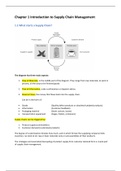Chapter 1 Introduction to Supply Chain Management
1.1 What starts a Supply Chain?
The diagram has three main aspects:
1. Flow of Materials, in the middle part of the diagram. They range from raw materials, to work in
process, all the way to the finished goods.
2. Flow of Information, order confirmation or dispatch advice.
3. Reverse Flows, the money that flows back into the supply chain.
Can be in the form of:
• Goods (Quality defect products or obsolete/outdated products)
• Information (Customer feedback)
• Packaging material (Outer cartons, boxes)
• transportation equipment (Cages, Pallets, containers)
Supply chains can be triggered by:
1. Product supply (commodities)
2. Customer demand (customized products)
The degree of customization dictates how much, and in which format the supplying company holds
inventory: no stock at all, raw or basic materials only or sub-assemblies of their products.
The strategies and associated decoupling of product supply from customer demand form a crucial part
of supply chain management.
,1.2 A Functional View of Supply Chain Management
Four Steps in Supply Chain Management:
Step 1. When you start engaging in supply chain management, you will most likely be confronted with
some of these questions:
• How many products are you going to sell?
• Where are you going to sell them and when?
• How much production do you need to schedule in your factory?
• What are your raw and packaging materials you need in order to fulfil the production plan?
All of these belong to the functional plan process, where demand and supply are balanced to develop a
course of action to meet sourcing, production and delivery.
Step 2. Once demand and supply are planned, and materials are sourced, you can start with actual
manufacturing of the products.
This process within the supply chain operations reference model looks at questions such as:
• How to set up manufacturing?
• How to make sure the production runs efficiently?
• How to improve the making process?
Step 3. After manufacturing, your products are ready for distribution or delivery. Under the deliver
function, all supply chain processes are included that provide finished goods to customers. Think about,
order management, warehousing, and transport management.
Step 4. The last process in the chain concerns reverse logistics or product return. This functional process
comprises all tasks that are associated with the return of product. Returns can occur for quality reasons,
for recycling or for post-delivery customer support.
, 1.3 Supply Chain Architecture
Let’s now have a look at the make-up and architecture of a supply chain. In its simplest format, a supply chain
consists of three nodes:
1. The company
2. The supplier
3. Customer
It looks like this:
A -> Simply supply chain
B -> Extended Supply Chain
Customers in supply chains can be distributors, wholesalers or retailers.
Distributors are companies that take inventory in bulk from manufacturers and deliver an assortment of
related product lines to customers. Distributors are companies that take inventory in bulk from
manufacturers and deliver an assortment of related product lines to customers.
Wholesalers, often known as cash and carry markets, buy from distributors or manufacturers directly.
They often specialize in certain product ranges and supply special industries, like hotels, restaurants and
catering, with larger quantities of products.
Retailers stock products in smaller quantities and sell them to the general public. These are the different
kinds of customers in a product supply chain.






